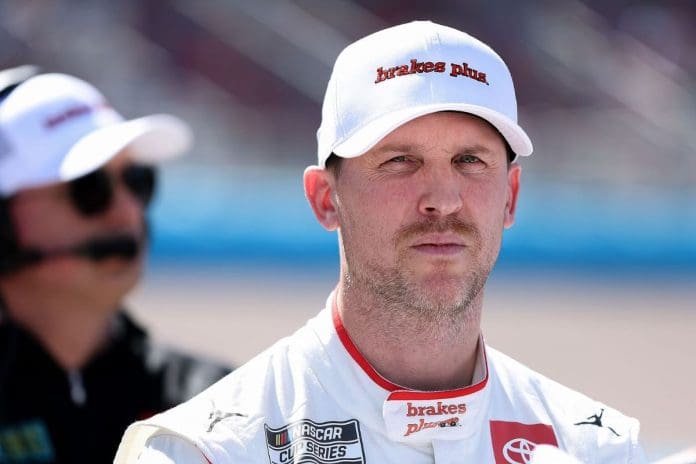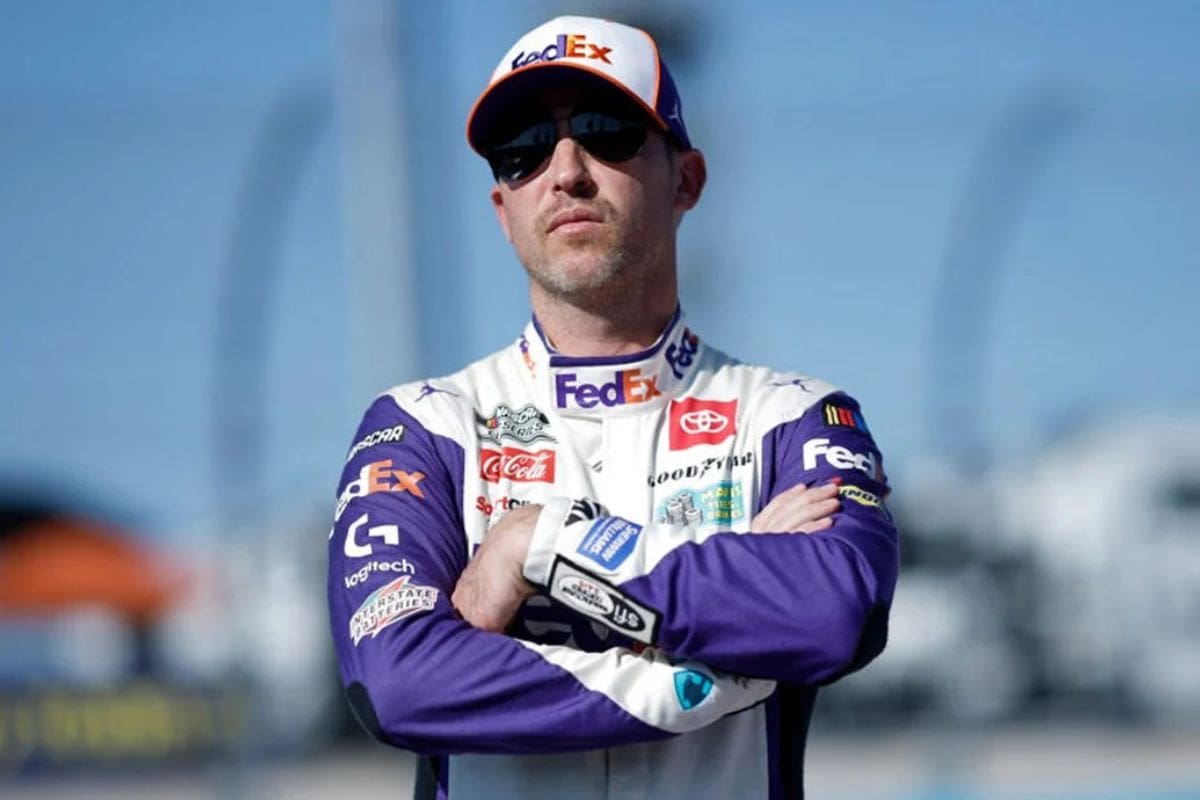Denny Hamlin Slams NASCAR: Denny Hamlin’s recent critique of NASCAR’s Next Gen car has ignited a significant discussion about the direction in which stock car racing is headed. Hamlin, a veteran and influential voice within the sport, labeled the Next-Gen car a ‘disaster,’ highlighting concerns over its performance, safety, and its impact on the competitive landscape. His comments have opened the floor to a broader debate about innovation versus tradition in NASCAR, and whether the series’ latest efforts to modernize and guarantee parity have accidentally compromised the essence of what has made stock car racing appealing to millions.
Key Takeaways
- Denny Hamlin criticizes NASCAR for failing to improve race quality and passing challenges with the Next-Gen car.
- Hamlin’s remarks highlight dissatisfaction with NASCAR’s efforts towards achieving parity among teams.
- His comments call attention to the need for NASCAR to address and enhance the racing experience.
- The critique serves as a catalyst for broader discussions on innovation and adjustments in NASCAR’s competition structure.
- Hamlin’s outspoken stance shows the urgency for strategic decision-making in evolving NASCAR’s future.
Lackluster Martinsville Race Disappoints Fans
The recent NASCAR Cup Series event at Martinsville Speedway, while not inherently flawed, failed to meet the high expectations for excitement typically associated with short-track races, casting a shadow of disappointment among fans. This underwhelming performance raised considerable concerns about the future engagement and appeal of NASCAR events, particularly those held on short tracks which are historically praised for their intense, action-packed racing dynamics.
Analyzing the event, it’s clear that the lack of anticipated excitement wasn’t due to a single, identifiable flaw but rather a result of factors that together contributed to a race that felt dreadful in comparison to the high-octane, experiences that fans have come to expect from Martinsville Speedway. The race’s inability to deliver on these expectations is significant, not just in the context of this singular event, but in what it suggests about the current state and direction of NASCAR racing.
Denny Hamlin Criticizes NASCAR’s Parity Efforts
Amid concerns raised by the weary Martinsville race, Denny Hamlin’s criticism of NASCAR’s parity efforts further highlights the challenges faced by the Next-Gen car in providing competitive and engaging racing experiences. Hamlin, a seasoned competitor within the NASCAR series, has articulated his frustration regarding the Next-Gen car’s impact on the sport’s competitive balance. His observations at Martinsville, a track known for its close racing and dramatic moments, emphasize a broader issue with the current state of NASCAR racing.
Hamlin’s critique serves as an important feedback loop for NASCAR’s regulatory body, emphasizing the need for a balanced approach to parity that does not compromise the racing quality. As the sport continues to evolve with the Next-Gen car, finding a middle ground that respects the drivers’ skill sets while promoting close competition will be paramount. Hamlin’s insights offer a valuable perspective on the adjustments needed to maintain NASCAR as a premier motorsports destination.
Hamlin’s Frustration with Passing Challenges
Frequently during the Cook 400 race, Denny Hamlin encountered formidable obstacles in lap traffic, particularly struggling to surpass Austin Dillon, which highlighted the deeper issues of NASCAR’s parity ambitions and the Next-Gen car’s passing dynamics. This incident emphasized a critical challenge facing drivers in the Next-Gen era: the seeming increase in difficulty of executing passes, even against lap traffic. Hamlin’s frustration was not a solitary lament but a symptom of a broader discourse questioning whether NASCAR’s drive towards parity has accidentally compromised the racing spectacle by making overtaking more challenging.
Analyzing the situation scientifically, several factors could contribute to the difficulties experienced by Hamlin and his peers. The Next-Gen car was introduced with the intention of leveling the playing field, featuring standardized parts and specifications aimed at reducing discrepancies in car performance. While successful in narrowing the performance gap, this homogenization may have also diminished the opportunities for skilled drivers to leverage superior car performance for passing maneuvers. Additionally, aerodynamic factors inherent to the Next-Gen design may aggravate the difficulty of following closely behind another car, further complicating passing efforts.
“We couldn’t even pass Austin Dillon for 50 or 60 laps. The last car on the racetrack, we could not pass him at the end of Stage 2. So here’s the problem, and I need someone to answer this is that if your goal is parity and everyone, all the cars to be the same, who do you think passing will happen? Do they think that one driver can overcome the dirty air the car in front of him is creating?”
“The racing needs to be fixed. I’m not saying anything that no one is not gonna be saying entire week, they’ve already said it. I’m sure the DBC guys will have issues with it; certainly, the teardown and the media have voiced their opinion on it. And I agree with them. Because if we sit back and do nothing, then shame on us, we deserve whatever is coming to us in the long run.”- (Denny)
Hamlin Calls for Racing Improvements
Reflecting on the challenges faced during the Cook 400 race, Denny Hamlin has vocalized a compelling call for NASCAR to implement changes aimed at improving the quality of racing, specifically through adjustments in horsepower and tire wear dynamics. Hamlin’s critique comes on the heels of a particularly strenuous Martinsville race, where the limitations of the Next-Gen car’s performance became glaringly apparent. The veteran driver’s recommendations pivot on two critical areas: an increase in horsepower and the introduction of more dynamic tire wear, both of which are intended to enhance the competitiveness and spectacle of NASCAR events.
Hamlin’s analysis is rooted in the belief that the current state of NASCAR racing, specifically with the Next Gen car, has stifled the drivers’ ability to effectively compete and entertain. By increasing horsepower, the belief is that cars would not only achieve higher speeds but also allow for greater speed variability, giving drivers more opportunities to overtake. The introduction of dynamic tire wear, on the other hand, aims to add a layer of strategic depth to races. This would make tire management a pivotal aspect of the competition, potentially leading to more unpredictable and engaging race outcomes.
“We keep tinkering with aerodynamics, I’m sorry we’re running 45 miles an hour in the middle of Martinsville. It’s not aerodynamics, it’s a horsepower to tire ratio. And until we get that through our fixed goals, the product will remain the same. But it will have to come up from the high-ups from NASCAR.” – (Hamlin)
Prospects of Future Racing Changes
As Denny Hamlin’s insights shed light on the shortcomings of the Next-Gen car, the racing community keenly anticipates NASCAR’s response to the proposed enhancements aimed at reviving the sport’s competitive edge. The discourse surrounding the potential for future racing changes has become a focal point, especially in light of observations from races like Bristol Motor Speedway. The critical nature of Hamlin’s reflections opens up a broader conversation about the adaptability and innovation required within NASCAR to improve the racing product.
The anticipation of adjustments by NASCAR is not merely about rectifying current issues but also about setting an example for the continuous evolution of the sport. It highlights the necessity for a dynamic approach to car design, race strategy, and overall competition structure that aligns with both the drivers’ expectations and the spectators’ desire for thrilling races. The prospect of future racing changes, thus, encompasses a multifaceted challenge that NASCAR faces in balancing tradition with innovation, safety with competitiveness, and spectacle with substance.
News in Brief
The criticism by Denny Hamlin of NASCAR’s Next-Gen car design brings to light significant concerns regarding the sport’s future. Particularly with respect to race quality, competitive balance, and fan engagement. It highlights the necessity for NASCAR to conduct thorough evaluations and make necessary adjustments to the car model.
Addressing these issues is crucial not just for enhancing the racing experience but also for ensuring the sport’s growth and sustainability in alignment with stakeholders’ expectations.
Our Reader’s Queries
Q. How did Denny Hamlin get into racing?
A. At 16, he dive into the world of racing, starting with mini stocks. Making an impressive debut at Langley Speedway, Hamlin not only secured the pole position but also clinched victory in his maiden stock car race. Subsequently, he advanced to the Grand Stock division in 1998 before transitioning to Late Model Stock Cars in 2000.
Q. Is Denny Hamlin still in NASCAR?
A. Denny Hamlin pilots the No. 11 Toyota for Joe Gibbs Racing in the NASCAR Cup Series, and he shares ownership of 23XI Racing with NBA icon Michael Jordan. His illustrious career boasts 53 victories, highlighted by notable wins in prestigious races such as the Coca-Cola 600 (2022), Daytona 500 (2016, 2019, 2020), and Southern 500 (2010, 2017, 2021).
Q. Has Denny Hamlin ever won a road race?
A. Hamlin secured his inaugural road course triumph by commanding just 10 laps of the 90-lap race, with those crucial moments unfolding towards the race’s conclusion.
ALSO READ: Did Denny Hamlin-SMI Drama Fool Fans? Insider’s Insight!





